In this Japan Bucket list we will cover the best things to do in Japan from the big tourist attractions to some of the best Japan hidden gems.
When we went to Japan, I have to admit it was love at first sight! I couldn’t believe how much I fell in love with this country and despite spending a whole month there I don’t think that I have even scratched the surface of everything that it has on offer! In this round up me and some of my favourite travel bloggers round up our favourite things that we think should we on your Japan Bucket List including some of the best Japan hidden gems !
Japan Bucket List including Japan Hidden Gems
Important Note: This post may contain affiliate links which means if you click through and make a purchase I will make a small commission at no extra cost to you!
Note about this bucket list: This bucket list is broken down into areas … loosely. It focusses on the two main cities of Tokyo and Kyoto, the northern island of Japan, Hokkaido and lastly the rest of the country. And if you want an itinerary that covers a lot of these attractions be sure to check out our 2 week Japan itinerary.
Tokyo Bucket List
As you know, Tokyo is the capital of Japan. So it should come as no surprise that Tokyo features heavily on this Japan Bucket list.
It is actually really hard to narrow down the attractions in Tokyo to form an achievable bucket list but we have tried to put together a diverse range of experiences, sites and activities to offer a unique bucket list for Tokyo.
Gotokuji Temple
Legend says that in the 15th Century, Tokyo’s Gotokuji Temple was a shabby hut overseen by a poor monk and the cat he cared for like his own child.
One day he asked the pampered puss to return his kindness by bringing good fortune to the temple. Soon after, the cat beckoned a wealthy feudal lord to enter the temple.
When a thunderstorm struck moments later, the lord believed he’d been spared from its ferocity by the cat. Grateful, he donated rice fields and crop lands to the temple and when it passed away, had the cat enshrined as Shobyo Kannon, the goddess of mercy.
The cat would become the inspiration for maneki-neko, the cat that’s now seen, paw raised to attract prosperity in people’s homes and businesses throughout Asia.
Located in the suburbs of Tokyo, Gotokuji is quieter than the city’s bigger tourist shrines, but is worth a visit. The temple grounds tree shaded pathways lead to the Butsuden Buddha Hall, past an ancient cemetery that adds a reflective tone, to a startling collection of hundreds of red and white cats stacked high around a statue of Kannon.
Nominated by Boy eats world
Senso-ji Temple
The famed Senso-ji temple is located in the heart of the bustling Asakusa district in Tokyo. Dedicated in 628, Sensoji is Tokyo’s oldest temple and is also the most-visited sacred site in the world.
During World War II, the temple was destroyed during an air raid, but was subsequently rebuilt and symbolizes peace, hope, and rebirth to the people of Japan.
The surrounding street stalls on Nakamise Street hold a plethora of options for snacks, treats, and souvenirs, so be sure to wander and experiment. Head over to the temple and its dramatic, 5-story pagoda just before sunset to catch a glimpse of vibrant colors fading into a dramatically lit structure.
Finally, stroll into the heart of Asakusa for a delicious and traditional Japanese dinner!
Nominated by Local Passport Family
Shibuya Crossing, Tokyo

Shibuya Crossing on everyone’s Tokyo Bucket List & Japan Bucket List
Known as the crossroads of the world, Tokyo’s Shibuya Crossing should feature on every Japan bucket list.
The maze of zebra crossings at the Shibuya intersection all turn green at the same moment and 3,000 pedestrians cross at its busiest times. The crossing is an intoxicating mix of bright lights and chaotic crowds and is most spectacular after dark when the neon billboards illuminate the streets below.
Shibuya Crossing is instantly recognisable from the movie Lost in Translation and, for us, it screams Tokyo!
After experiencing the thrill of an iconic crossing our favourite vantage point is one of the highly coveted window seats at the Starbucks Shibuya Tsutaya for a birds eye view.
While visiting Shibuya Crossing make sure to stop by the statue of Hachikō, the loyal dog who awaited his dead master’s return from work for over 9 years at Shibuya. Hachikō is well loved in Tokyo and his story warmed our hearts.
Nominated by Show Them the Globe
Studio Ghibli Museum
One thing we can’t miss when we’re in Tokyo is the incredible Ghibli Museum.
Even though you need to buy the tickets in advance (through Lawson convenience stores or through your travel agent), you can’t take photos inside, and it’s always super crowded, it’s always amazing.
There are the permanent exhibits, that are beautiful and entertaining, no matter how many times you see them. But there are also temporary exhibits, and they always take our breath away. Once we got to sit inside the Cat-bus (from My Neighbour Totoro), and on other time, we got to play with the food from the many Ghibli movies.
Your ticket gives you access to the whole museum and an exclusive short movie. You can even visit Ghibli Museum with the kids as there’s lots of child friendly amenities including a restaurant inside that is beautiful, and a kiddie playground featuring the black soot and the cat bus (only for those under 12, though). The shop has a wide variety of Ghibli things and it’s worth a stop.
It is essential to buy these tickets well in advance – to buy yours online CLICK HERE!
Nominated by World Trip Diaries
Tsukiji Outer Market
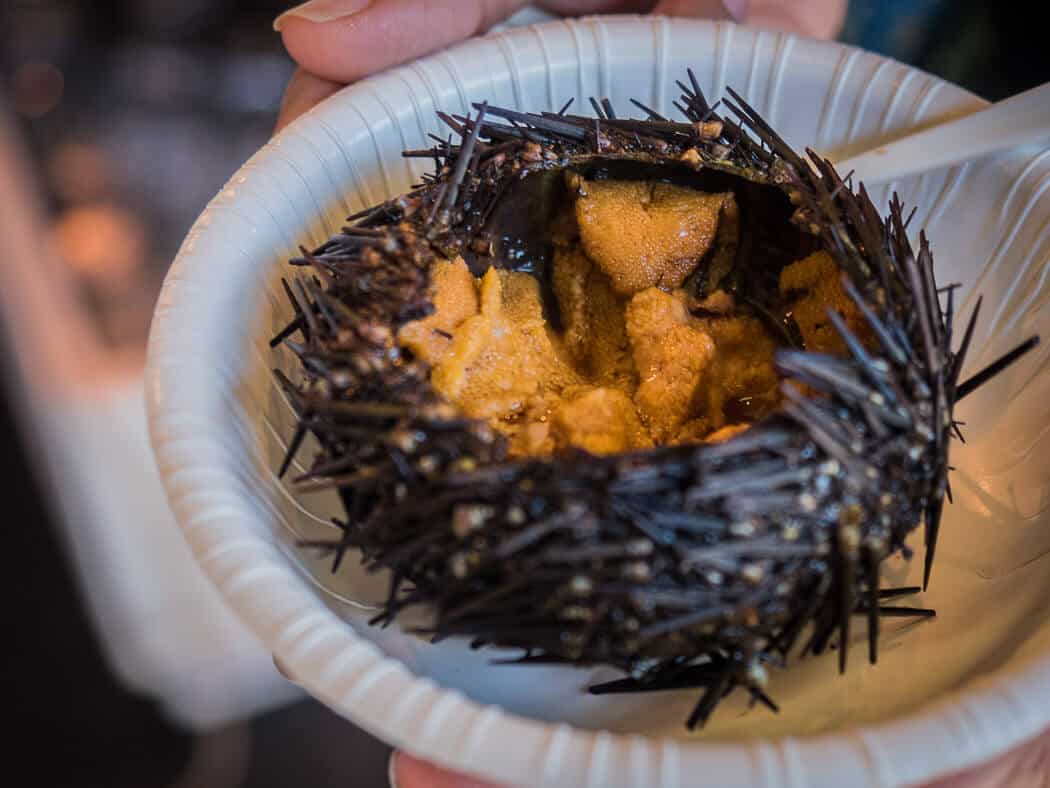
japan hidden gems – Tokyo Hidden Gems – the fish market
One of the must visit Japanese culinary destinations, especially for lovers of fresh seafood, is the Tsukiji Outer Market in Tokyo, where there are stalls, restaurants, and shops dedicated to providing visitors with a large variety of delicious eating options.
One of the best ways to experience the market is to move from stall to stall trying smaller dishes and snacks.
Some of the more well-known dishes and snacks available throughout the market include otoro bowls (fresh high-end salmon belly that melts in the mouth), huge freshly shucked oysters, grilled Japanese spider crab legs, dried fish (the dried octopus is to die for), and my favourite, the murasaki sea urchin.
For a sit down meal, step inside one of the small restaurants, where you can watch the chef prepare mouth-watering plates of sushi and sashimi right in front of you.
There are a few non-seafood snacks to try, with tomago, a sweet and fluffy omelette, being a unique specialty of the market, and to round out the eating experience, there are sweet treats on-hand including the ever popular warabimochi, the decadent ichigo daifuku, and a range of relatively expensive fresh fruits.
The Tsukiji Outer Market is one of Japan’s great seafood experiences.
Please Note: closed Sundays and some Wednesdays.
If you would prefer to experience the market with a guide click here for information!
Nominated by The Roaming Fork
Visit Disneysea
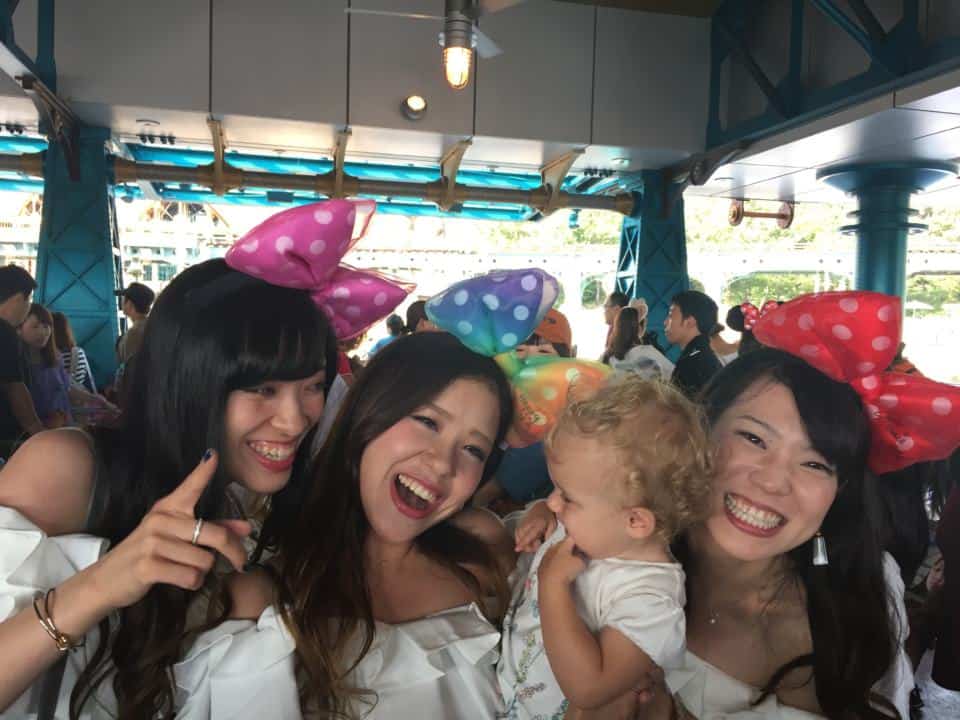
Bucket List Japan Edition – including hidden gems Japan
Ok, I know this doesn’t sound like the most cultural of excursions but to me no visit to Tokyo is complete without a trip to Disneysea.
Whereas there are Disneylands across the world, including the original in California as well as Tokyo, Hong Kong, Disneyland Paris and Shanghai, however Disneysea is completely unique to Japan!
The theming is outstanding with worlds based on geographic waterways including Mermaid Lagoon, Arabaian Coast, Port Discovery, Lost River Delta, Med Harbour, American Waterfront and Mysterious Island.
The attention to detail is amazing and if you want a unique experience this is the park for you! I also love how into the day the Japanese get, it is not uncommon to see Japanese groups all dressed up identical for their trip. The atmosphere is absolutely brilliant and is a must for your trip to Japan.
Top Tip: To be sure of not having to queue at the start of your day make sure you book your tickets in advance!
For more toddler friendly thing to do in Tokyo check out this guide!
Mount Fuji Day Trip
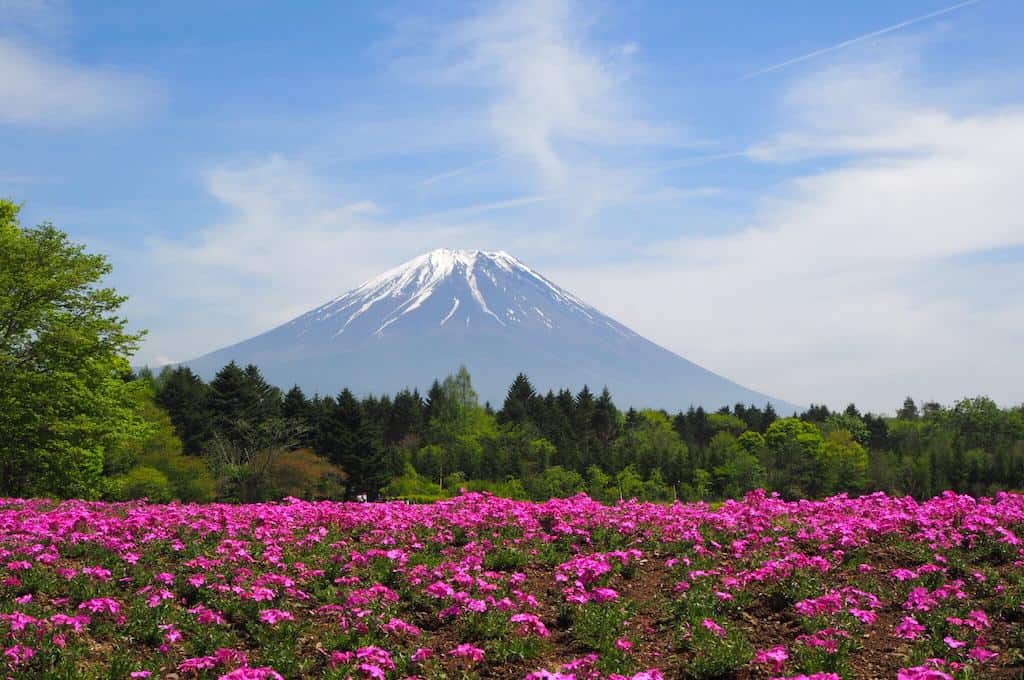
Fujishibazakura – hidden gems in japan
Mount Fuji is a magical place in Japan that should definitely be on your bucket list. It’s only about 100 kilometers from Tokyo, so it’s an easy day trip from there.
If you’re lucky and it’s a clear day, you’ll be blessed with amazing views the whole day. Be sure to check out the weather forecast before you go, as it’s not always possible to see Mount Fuji due to clouds and low visibility.
There is enough to do at Mount Fuji. Go to the Chureito Pagoda for the iconic view of the temple and Mount Fuji as a backdrop, roam around Iyashi no Sato, a site of a former village on the western shores of Lake Saiko.
Or visit the Fuji Shibazakura Festival, a beautiful flower festival that takes place between April and May!
You can also decide to spend a night at Mount Fuji at an onsen, a traditional Japanese bath. There are many great places where you can stay with an onsen and a view of Mount Fuji.
If you want to go to Mount Fuji on a day trip check out tours HERE!
Nominated by Chapter Travel
Visit the Fuji Shibazakura Festival
Many people come to Japan to see the famous and incredibly beautiful Mount Fuji. There are many places where you can do that (and they are all not too far from Tokyo).
I have visited many of the best places to see Mount Fuji, even multiple times. But if you asked me which Mount Fuji viewing spot should be placed on a Japan bucket list, I would say the Fuji Shibazakura Festival.
This flower festival is held once a year between April and May in Fujikawaguchiko and draws huge crowds. The Shibazakura, little dark pink flowers, cover the whole park which also features a replica Mount Fuji made from flowers, a small picturesque pond and some food stalls and a restaurant.
But as I said, what is really impressive here is the view of Mount Fuji. You get a see of beautiful pink flowers in the foreground and the impressively big mountain in the background. It is an unforgettable sight to be sure.
Nominated by The Social Travel Experiment
The Robot Restaurant
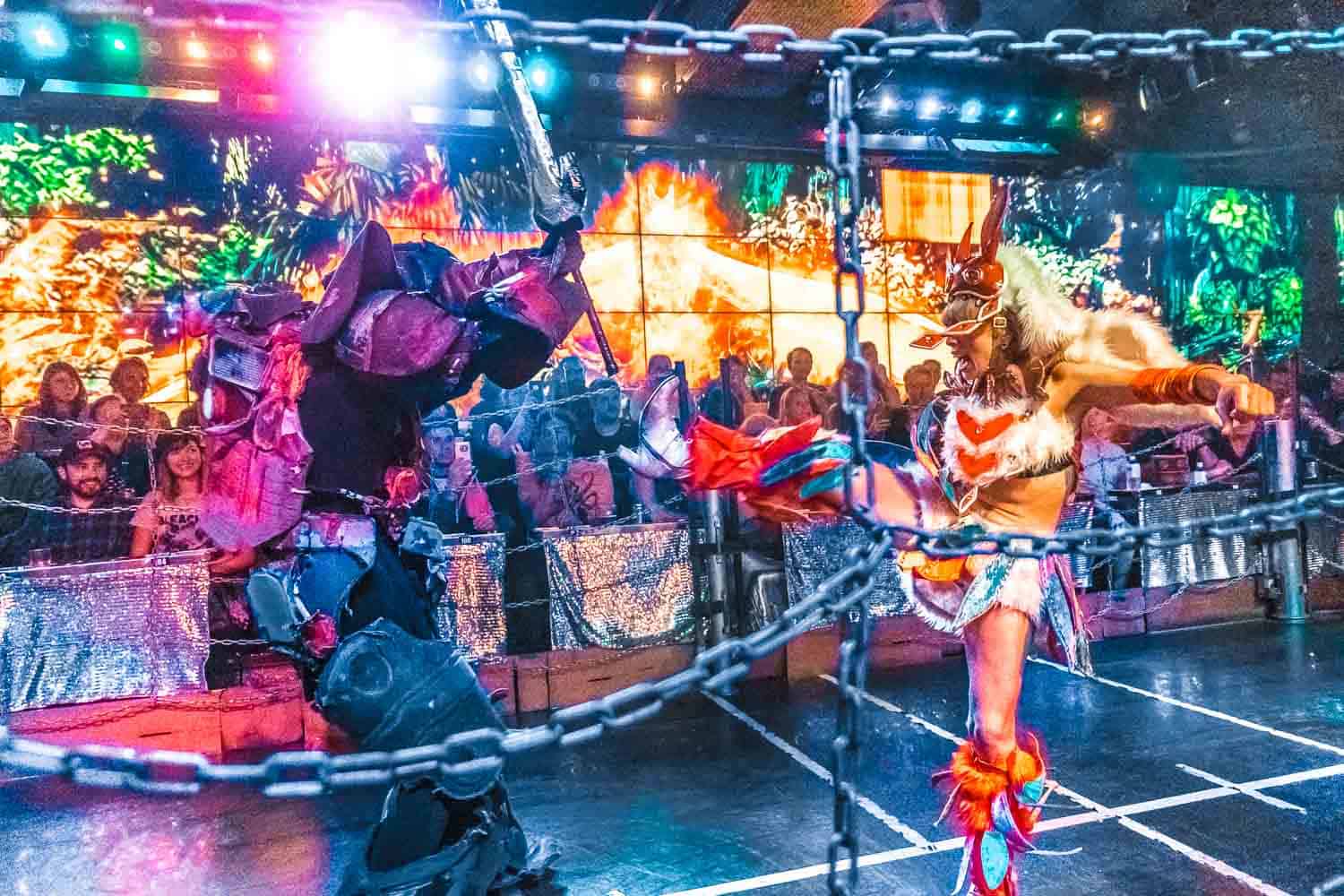
hidden gems of japan – Robot Restaurant – Japan Hidden attractions
The Robot Restaurant in Tokyo is one of the craziest attractions in all of Japan. It’s a spectacle show that you can attend in Shinjuku, and tickets go from about 70 USD per person. The price might seem steep, but it’s well worth it.
For 90 minutes, you will experience something that I guarantee that you’ve never seen before. It’s an epic mixture of robotic dancers, singing characters and dancers, ninjas, monsters at the same time as J-Pop is played, and the occasionally role-playing scenes where the actors will become characters from the stories.
And of course neon-lights everywhere, dragons fighting robots, robotic turtles with flame-throwers, robots dancing to Michael Jackson and much more.
It’s really an experience that can’t be described by words, you have to be there to understand how good the show really is. The Robot Restaurant show is pure sensory overload in every thinkable way.
To book your tickets online in advance CLICK HERE!
Nominated by the Swedish Nomad
Eating Ice cream At A Maid Café
Japan is all about cosplay and anime culture. In Tokyo, at Akihabara Electric Town, you will see Anime/Manga come to life in the form of cosplay cafes and stores that are dedicated to this genre. The Maid Café at Akihabara, even though not directly related to a particular Anime/ Manga, are still a part of this Otaku culture.
I visited one such café in Electric town. The experience was truly one of a kind. Everything, from the décor, to the costume of the waitresses and the ice-cream, was cute. There is an element of embarrassment thrown in as well as you are not just a witness to the display but are made a part of it when you wear bunny ears and chant a short Japanese song when your ice-cream arrives. The ice-cream, of course, was delicious as well.
To book your Maid Experience in advance CLICK HERE!
Nominated by Traveling Pari
Stay in a Capsule Hotel
Capsule Hotels are the ultimate in Japanese places to crash, a cultural experience even! They’re also substantially cheaper than hotel rooms or even AirBnB apartments so can be a great choice if you’re staying in a big city – although not so much for families.
I stayed in capsule hotels when I went to Tokyo for a few days and it worked great. The capsules themselves are small, but big enough – 1m x 1m x 2m long. Enough room to sit up in or stretch out straight or turn over from side to side without hitting the sides. Even as someone who is taller than average I felt like I had enough space to get comfortable. I got a good night’s sleep on each of the nights I tried a capsule hotel.
Facilities at capsule hotels can vary but the larger ones have their own small Japanese bath houses (sentos), dining areas and TV rooms. The capsules themselves have pillow, sheets, blanket, tissue box and a small TV (with only Japanese channels) and radio and often an alarm as well. And everywhere has vending machines for snacks, noodle cups and drinks.
On the downside, the foot of my capsules either had a curtain or a thin roller door which didn’t always block out snores or drunken stumbling from other guests but did a better job than a hostel. Also you had to be out of the sleeping areas during certain hours for cleaning Those issues aside, I loved my capsule stays. They really added to the Japaneseness of my trip!
For rates on Capsule Hotels CLICK HERE!
Nominated by Simpler and Smarter
Watch Sumo Wrestling
Watching sumo wrestling in Japan should be high on any bucket list. Sumo wrestling is Japan’s national sport with a long history that dates back to ancient times.
Professional sumo tournaments take place six times a year in four cities in Japan, including Tokyo which hosts three of those tournaments. Watching sumo wrestling at a tournament is an exciting, unique and interesting cultural experience. There are many traditions and rituals including singing, foot stomping, salt-tossing and ring entering ceremonies (the actual wrestling part of a sumo match is very short).
While each day of a sumo tournament is long (starting in the morning with lower ranked wrestlers and ending with the top ranked wrestlers), most people show up in the afternoon just in time to see the higher ranked wrestlers compete. If you are not in Japan during a tournament but still want to see sumo, some sumo stables (houses where wrestlers train and live together) allow visitors to come and view their morning practice sessions.
To book your Sumo Wrestling Experience CLICK HERE!
Nominated by the Travel Sisters!
Kyoto Bucket list
Although I loved Tokyo, Kyoto for me was the true star of our visit to Japan! We literally loved everything about it and it was so easy to travel to Kyoto with kids! In this section we round up literally the best of the best Kyoto has to offer – and this is not an easy job as it is such an awesome city!
Walk the Gates at Fushimi Inari Taisha

In short, Fushimi Inari Taisha is the most beautiful shrine in Japan in my opinion. It has to be on any japan bucket list! It is the head shrine of the Inari.
It sits at the base of Mount Inari and thousands of torii gates can be followed up to the summit of the mountain. In the summer Fushimi Inari Taisha gets really hot and humid.
You may want to plan your day around the heat to make sure your visit as comfortable as possible especially if you plan to walk all of the gates!. Also remember to take plenty of snacks and more importantly water.
If you want to experience Fushimi with a guide click here!
See Geishas in Gion
The Gion district is one of the last remaining real geisha districts and therefor one of the best areas in Japan to spot geishas. Geishas are something unique to Japan. Their richly decorated kimonos and perfect white faces with fierce red lips ensure a stunning appearance.
There’re only about 1000 geishas left in the whole of Japan and their services are usually reserved to the Japanese elite. If you want to see a Geisha you can book one of the shows that are specially organized for tourists or you could take a walk around the Gion district.
The latter is at least as nice as the first. We loved wandering through the charming old streets of Gion, hoping to spot a Geisha with every corner we took.
Walking through these streets lined with authentic old Japanese buildings felt like we had been flashed back into time. With some imagination we could have been back in ancient Japan.
Along the way we saw colorful cherry blossoms and magnificent temples but the icing on the cake were the 3 Geishas that crossed our path.
For a walking tour of Gion CLICK HERE
Nominated by Wapiti Travel
Hear the Nightingale Floors at Nijo Castle
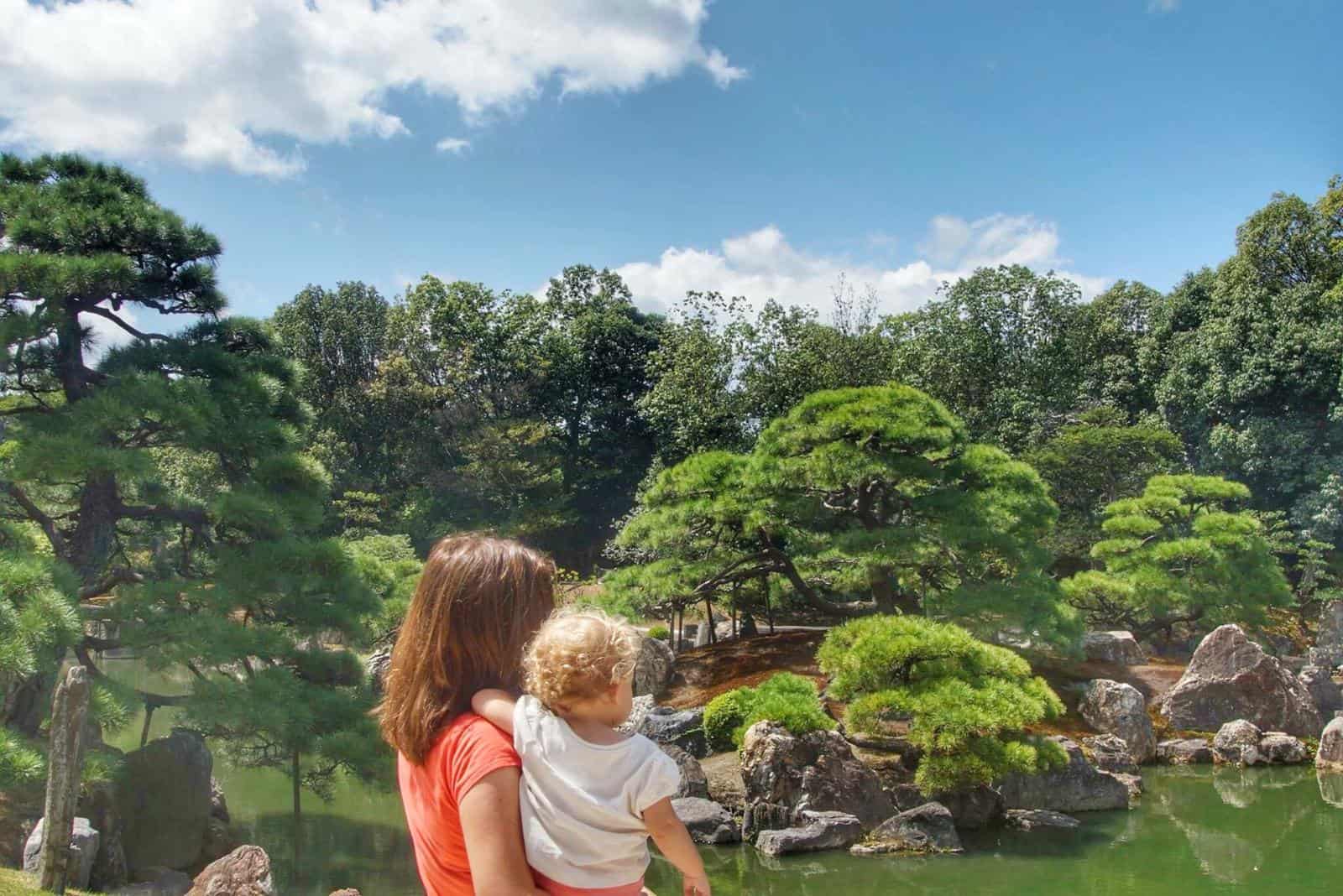
Kyoto Bucket List – hidden places in kyoto and secret places in Japan- Nijo Castle
Not often found in the guidebook top ten lists but one of our favourite things to do in Kyoto was visit the beautiful Nijo Castle!
Built in 1603 by the first shogun of the Edo-era. He complex is vast complex and is built up of spectacular grounds and several open to the public buildings.
A highlight of our visit was taking off our shoes to explore the main castle building! Most of all we loved listening to the nightingale floors as we stepped on them – apparently an early security measure! Be sure to grab the audio guide to learn more of the castle history.
Not to be missed at the castle is the grounds however as the gardens in the complex were my favourite that I visited in all of Japan.
You can book your admission tickets online in advance HERE!
A visit to Saiho-ji (also called Koke-dera, the Moss Temple)
A visit to Saiho-ji (also called Koke-dera, the Moss Temple) starts with a ritual experience inside the temple to put visitors in the right frame of mind to visit the moss garden. This could be ritual chanting of sutras, meditation or copying the heart sutra. This is especially fun, as it is also an introduction to Japanese calligraphy. There is something calming about copying Japanese characters using a brush and ink, even if you don’t understand what the kanji characters mean.
After everyone is sufficiently contemplative, the gardens are opened. There are over 200 varieties of moss, naturally growing after the gardens were inadvertently flooded hundreds of years ago. The gardens are set around a heart-shaped pond.
Walking through the trees, past the tiny islands that help make the shape for the Japanese character for ‘heart’, and several wooden teahouses semi-hidden amongst the trees, is a calming and serene experience, especially after the initial rush of people passes.
Visits to the temple are by appointment only. Unless you live in Japan, the easiest way is to ask your hotel to make the reservation for you, at least a month in advance.
Nominated by Travel Collecting
Visiting Kinkaku-ji aka The Golden Pavillion
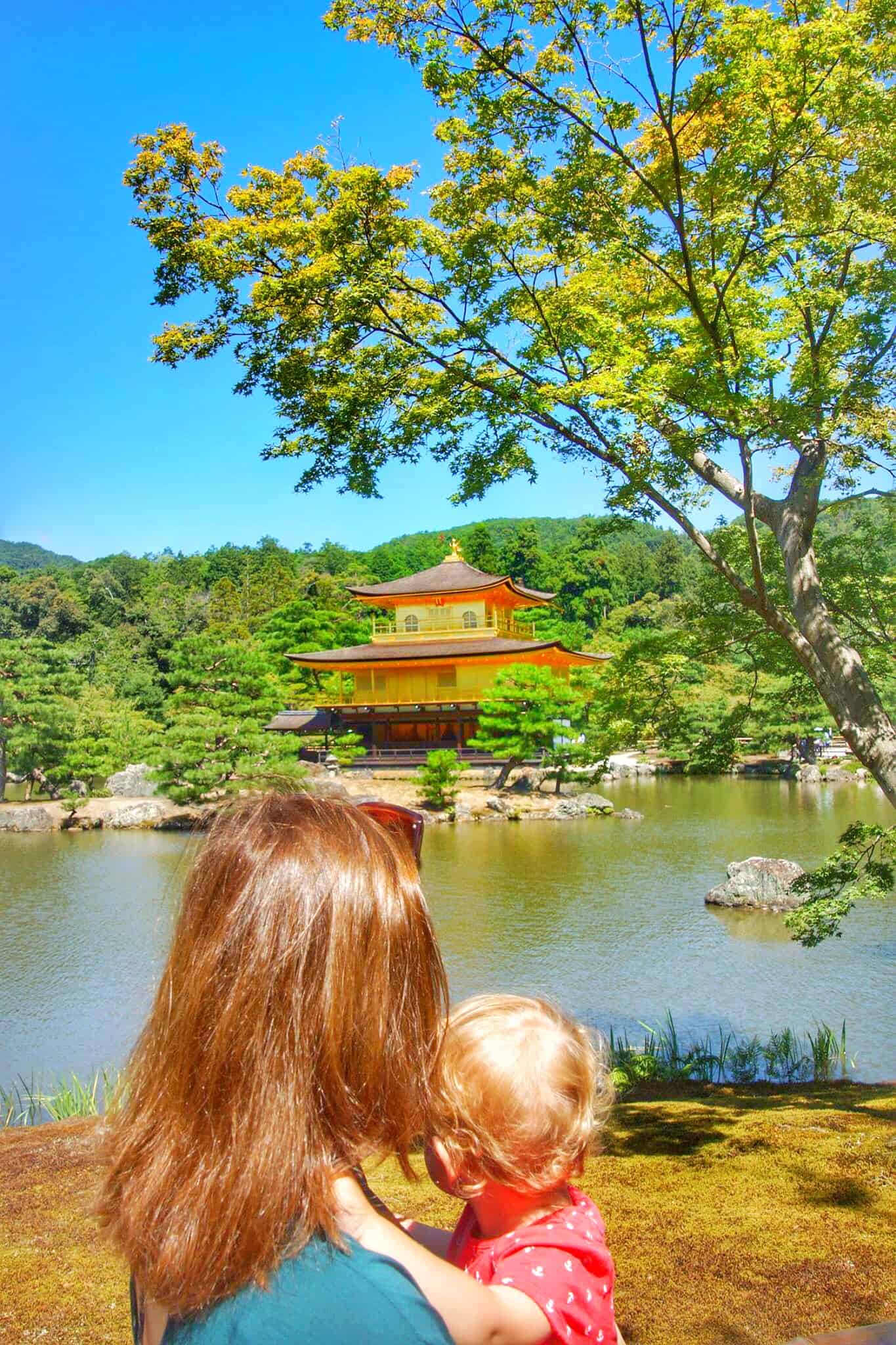
Golden Pavilion should be on your bucket list for Japan
If you ask many people what is the one thing they want to see in Japan, The Golden Pavillion, formally known as Kinkaki-ji, will undoubtedly be high on that list! On a sunny day the pavilion is simply dazzling! Sat on a pond, I think it may just be one of the most photogenic places I have ever been!
Note: This was definitely the busiest place we visited in Japan – be sure to arrive very early to try and beat the crowds!
If you want to experience the Pavilion with a guide click here for more information!
Stay in a Ryokan
One of the unique things about staying in Japan is that it has its own traditional style of accommodation, namely Ryokans. This type of hotel dates back to ancient times (eighth century A.D), and their architecture and decoration reflects that.
As opposed to hotels that stay with the times, ryokan give you great sense of Japan’s traditional past. It’s like staying in a history museum – A luxurious one though, and one with modern comforts added.
The only downside of staying in a ryokan is that they’re relatively expensive compared to hotels, but luckily there are some budget options available too…
Ryokan can be found all over Japan but the best place place to look for them is in Kyoto, the traditional heart of Japan.
You can check availability of Ryokans in Kyoto here!
Nominated by Journeys Compass
Kyoto International Manga Museum.
Kyoto International Manga Museum is located a two minute walk from the Karasuma-Oike Subway Station (5 minutes, 210 yen from Kyoto Station).
The Manga Museum in Kyoto is the perfect place to explore and as a family be able to connect with locals in the children’s library section, browse through Japanese comics and the best thing of all get a special portrait done from one of the amazing artists on site.
There are usually two artists available and working most days but it is best to check online for the months schedule. The portraits are conducted from 11am-5pm on weekends. They cost 1,500 Y each. We visited over Summer and had to wait for round 30 mins for our turn.
The artists are friendly and engaging and we were thrilled with the results of one of our treasured Japanese holiday memories.
Nominated by Smiths Holiday Road
Feed the deer at Nara Park
No trip to Nara is complete without a visit to Nara Park, one of the oldest parks in Japan, which is famous for the masses of deer found roaming freely.
There are over 1000 deer in the park and it’s amazing to spend an hour getting up and close with these beautiful creatures.
Japanese people are known for being very polite and these customs extend to the deer too. You’ll want to bow before approaching a deer and offering it a biscuit as a sign of respect and the deer might just bow back!
For your own safety you should finish any food you have on your person before entering the park so the deer don’t start sniffing around your backpack. You can purchase special biscuits to feed the deer all around the park and it is important that you only feed them this.
Remember to treat the deer with respect, don’t tease them or try play with them; they are wild animals and can be unpredictable if you provoke them.
For information on day trips to Nara CLICK HERE!
Nominated by What’s Hot Blog
Sake tasting in Nara
All templed-out and tired after a long day exploring Nara and making friends with the gorgeous local deer? For something a little different, why not rest those weary legs with a round of sake tasting!
Pop into Harushika Sake Brewing in the backstreets of Nara to sample sake, a traditional Japanese rice wine. For only Y500, you’ll get to try five or six different sakes.
If you’re not a sake connoisseur, your tastebuds are in for a treat as they discover the surprisingly diverse range of sake flavours.
When they’re lined up one by one, the flavours and notes of the sake really explode. You’ll experience dry sake, strong sake, fruity sake, and even cloudy fizzy sake. Harushika Sake Brewery will also give you a small sake glass to remember your experience.
Speaking of memory, be careful: sake does have a higher alcohol content than beer and wine. However, the sake tastings are shot sized, so you should leave feeling light and happy rather than sloshed. The perfect break before getting back to Nara’s other highlights – temples and deer!
Nominated by
Arashiyama Bamboo Grove
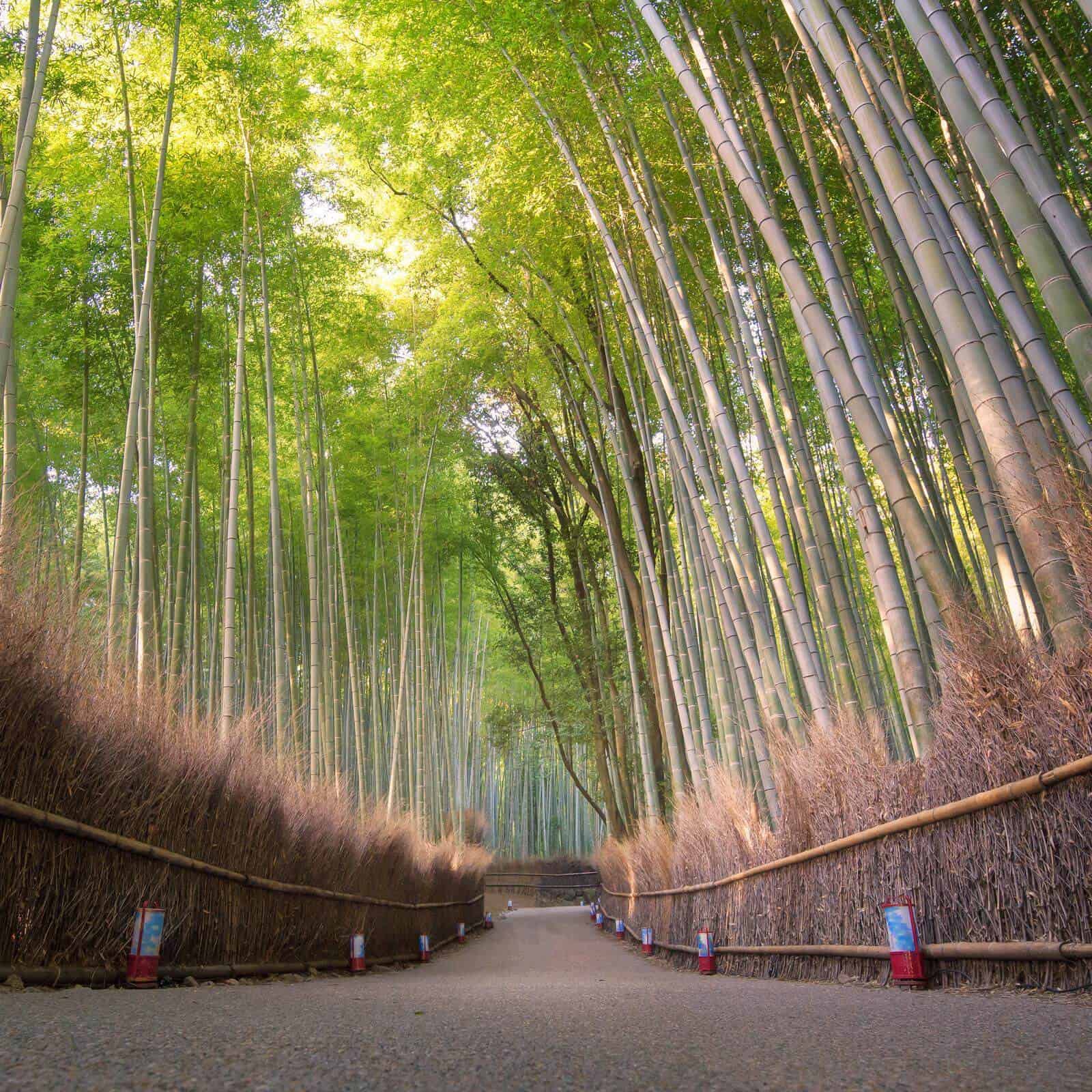
Arashiyama Bamboo Grove should be top of your Japan Bucket List
Visiting Arashiyama Bamboo Grove and the surrounding areas is the perfect activity to add to your Japan bucket list. Arashiyama is easily accessible on the Randen from Shijo Omiya station in Kyoto and the ride out there takes under half an hour.
Once there, you’ll be minutes away from one of the most photographed spots in Japan, the lush green of the Bamboo Grove. Walk through the grove and listen to the gentle rustling of the trees and keep an eye out for Japanese locals in traditional dress.
There are many temples around the area to visit, too, with the beautiful halls and gardens of Tenryu-Ji being the most famous. Another quaint little shrine to visit as you walk the grove is the Nonomiya shrine where imperial princesses used to purify themselves.
There’s plenty to see around the area and there’s also many street vendors around to grab some sticky rice cakes or dumplings for a cheap and quick lunch on the go.
For organised day trips to Arashhiyama Bamboo Grove Click HERE!
Nominated by Emma Jane Explores
Okunoin Cemetry – a Japan hidden gem
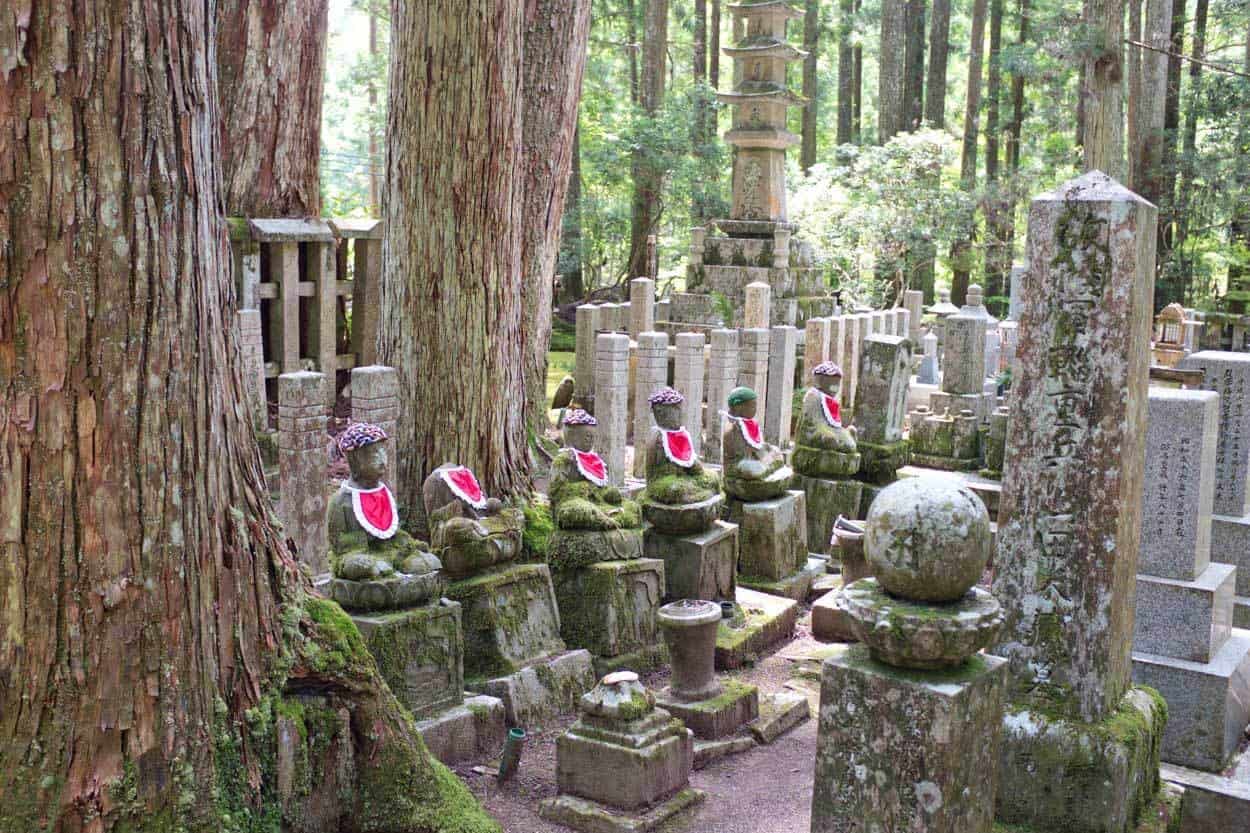
The small town of Koyasan is hidden in the mountains of Wakayama Prefecture, around 60 miles from Osaka. The town is one of the holiest in Japan. In the 9th century a monk by the name of Kobo Daishi brought Shingon Buddhism to Japan and established its first temple in Koyasan.
Today there are over 100 temples in Koyasan, a small town of only around 3,000 people. At the far end of the town is Okunoin Cemetery, the largest in Japan and a World Heritage Site. Kobo Daishi himself is buried here, making it one of the holiest pilgrimage sites in Japan.
Okunoin cemetery is an incredibly atmospheric place. Shrouded beneath the forest of Wakayama, there are over 200,000 graves at Okunoin, many dating back several centuries. A long path winds past the moss covered tombstones, and torii gates that fill the cemetery
A two kilometre lantern-lit path leads to Kobo Daishi’s mausoleum. Buddhist monks still leave offerings beside his grave daily, believing that he rests in a state of permanent meditation. Okunoin cemetery is at its most ethereal at dawn or just as the sun begins to set. Night tours of the cemetery are also available.
Nominated by Where You’re Between
Hiroshima Bucket List
Miyajima and the Floating Shrine
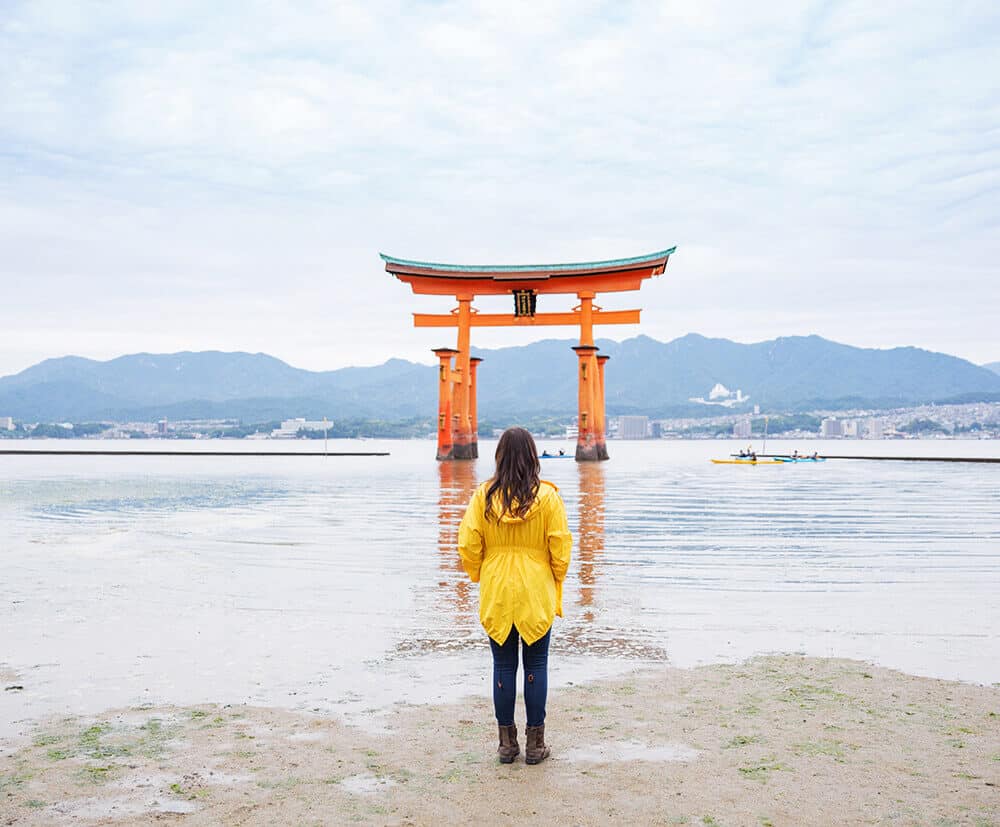
Japan Bucket List Miyajima floating shrine-
If you’ve ever looked at pictures of Japanonline, you’ve most likely come across this famous floating shrine without even knowing where or what it is! This is the floating Torii of Itsukushima Shrine on Miyajima Island, located in the south of Japanand tucked into Hiroshima Bay. Miyajima island is easily accessible from Hiroshima by taking the HER (Hiroshima Electric Railway) and then a quick ferry to the island.
The famous floating shrine, called a Torii, will greet you as you dock. A Torii is a Japanese gate between the normal every-day world and a sacred place, in this instance, the Itsukushima Shrine.
This is the third most visited site in Japan, and well worth taking a day trip to! You can view the Torii during high tide or low tide. Both views are equally stunning and worth sticking around all day to witness.
The Torii isn’t the only thing to see on Miyajima Island though. When you first exit the ferry, you’ll most likely be visited by the cutest Sika deer! Kids usually love this and it’s a big highlight of the time on the island for them.
Hiroshima Peace Park
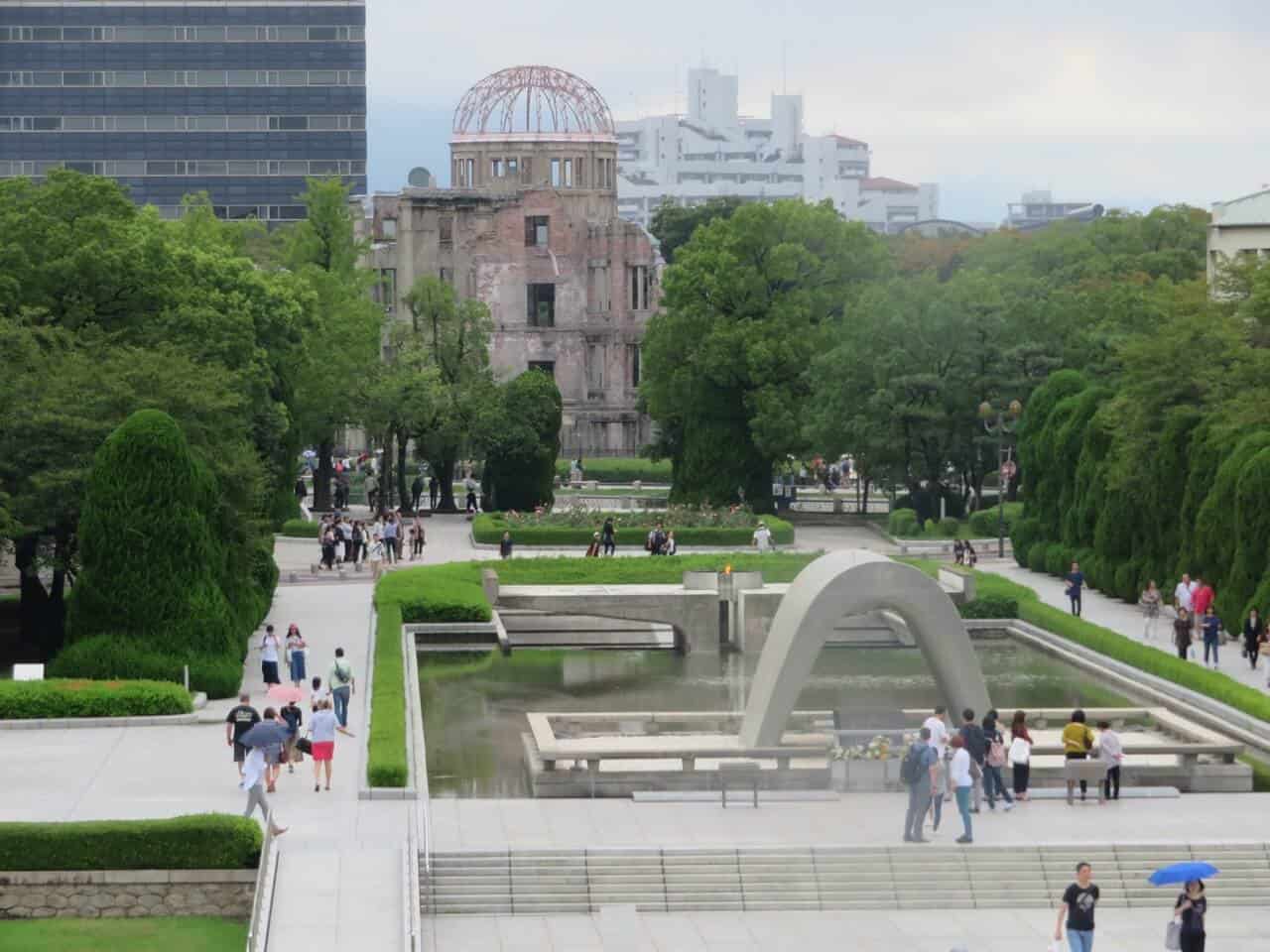
Hiroshima was one of the many highlights of my trip to Japan. I expected it to be a somber experience but I also knew it was an experience I had to have. The Japanese have done an incredible job of honouring the lives of those hundreds of thousands of people and have also made it a place for everyone to learn, learn why we should never have to experience such devastation again.
I took my 12 year old daughter to Hiroshima, she had been learning Japanese at school. Her teacher had discussed Sadako Sasaki, a surviver of the nuclear bomb and her experiences are well documented. We went to the Children’s Peace Memorial and rang the bell honouring those children that perished that day. We donated a paper crane in her honour.
I love the Peace Flame and the message it sends – the Peace Flame will burn until the very last nuclear weapon on earth has been destroyed. You can see the flame burning in my photo, I hope I return one day and find that flame is extinguished.
Nominated by our 3 kids vs the world
Hokkaido Bucket List – one of the hidden gems in Japan
Hokkaido is the Northern Island of Japan and actually is a Japan hidden gem in and of itself. Not many people venture to the Northern island, instead sticking to the southern island of Honshu.
Our favorite things to do on Hokkaido are listed below. And if you are visiting Hokkaido with kids be sure to check out this post.
Walk the Canals of Otaru

The canals of Otaru are a must when visiting Japan’s Northern island Hokkaido! The Venice of Japan – although on a much smaller scale, this canal city is simply stunning. Other things of note to do in Otaru include trying your hand at the local craft glassblowing and eating sushi on the famous Sushi Street!
Try Hokkaido Dairy
Hokkaido dairy products are famous and one of the most popular ways to eat it is in soft serve ice cream form! You can get traditional flavors such as Matcha but we also tried Squid Ink Ice Cream a Hakodate speciality! It tastds like a cross between having a whisky after taste and metallic taste it divided the crowd!
Hakodate Mountain – a hidden gem Japan
Located in Hakodate, you take a short bus ride up to the top of the mountains for some of the best views in Hokkaido! It is particularly stunning at night as you the city lights twinkle! Hokkaido as a whole is the least visited part of Japan for tourists and Hakodate is a special hidden gem Japan that you should definitely add to your Bucket List Japan edition.
Go in search of bears at Shiretoko National Park

Hokkaido has several National Parks but the one we went for was Shiretoko! A designated UNESCO World Heritage site with easy hikes. The main entrance is at Shari and is the easiest place to go with kids. But one special way to see the park is to take a cruise. On our cruise we managed to see the symbol of the park the elusive Brown bear! We really enjoyed Shiretoko as it was such a contrast to the rest of the Japan with its busy cities and ancient shrines and temples.
Rest of Japan Bucket List including Japan hidden attractions
Shirakawa Go by Priya Vin from Outside Suburbia
It is a long journey to get to these distinctive houses often called the Japan’s Snow Houses and we were looking forward to seeing them in person at Shirakawa Go. We boarded a bus at the Nagoya station bright and early at 7:50 am for a 12 hour road trip to the snowy Alps.
Our first stop was Takayama, known as little Kyoto. After exploring for an hour and a hotpot we made our way to Shirakawa Go. Snowfall in this region can get pretty intense and the area gets covered in 1 to 2 meters of snow, making the town into its own unique winter wonderland. The Gassho-style houses found in the Historic Villages of Shirakawa-go are rare examples of their kind in Japan.
The steep straw-roofed homes are made of wood. Due to harsh and unforgiving winters with a lot of snow, the roofs of the houses are steeply angled to prevent the snow from piling up. Called Gassho-zukuri houses which means “constructed like hands in prayer”, as these farmhouses’ steep thatched roofs resemble the hands of Buddhist monks pressed together in prayer.
Nominated by Outside Suburbia
Takada Castle and Park in Joetsu
Your Japan bucket list doesn’t have to include the same famous attractions everyone else visits. While it’s true that they’re famous for a reason, the experience can get tainted by the excessive number of tourists you may find around you. If you’re looking for alternative (yet still incredibly magical) places to add to your bucket list, the city of Joetsu, and specifically, the Takada Castle and Park, is certainly one of them.
The original building of the Takada Castle dates back to the seventeenth century, but the biggest attraction isn’t the flatland castle in itself, but rather its prime location in the middle of a stunning park.
You’ll be delighted by this area no matter the time of the year you visit. The Winter is especially magical for its snowy mountain views and activities, but this area (literally) lights up in the Spring during the cherry blossom season. The Takada Park counts with more than four thousand trees, beautifully illuminated by paper lanterns. It is actually one of Japan’s most famous nighttime cherry blossom viewing events. There are plenty of other festivals and attractions to visit in this area, which you can easily access by train or car.
Jigokudani snow monkey park!
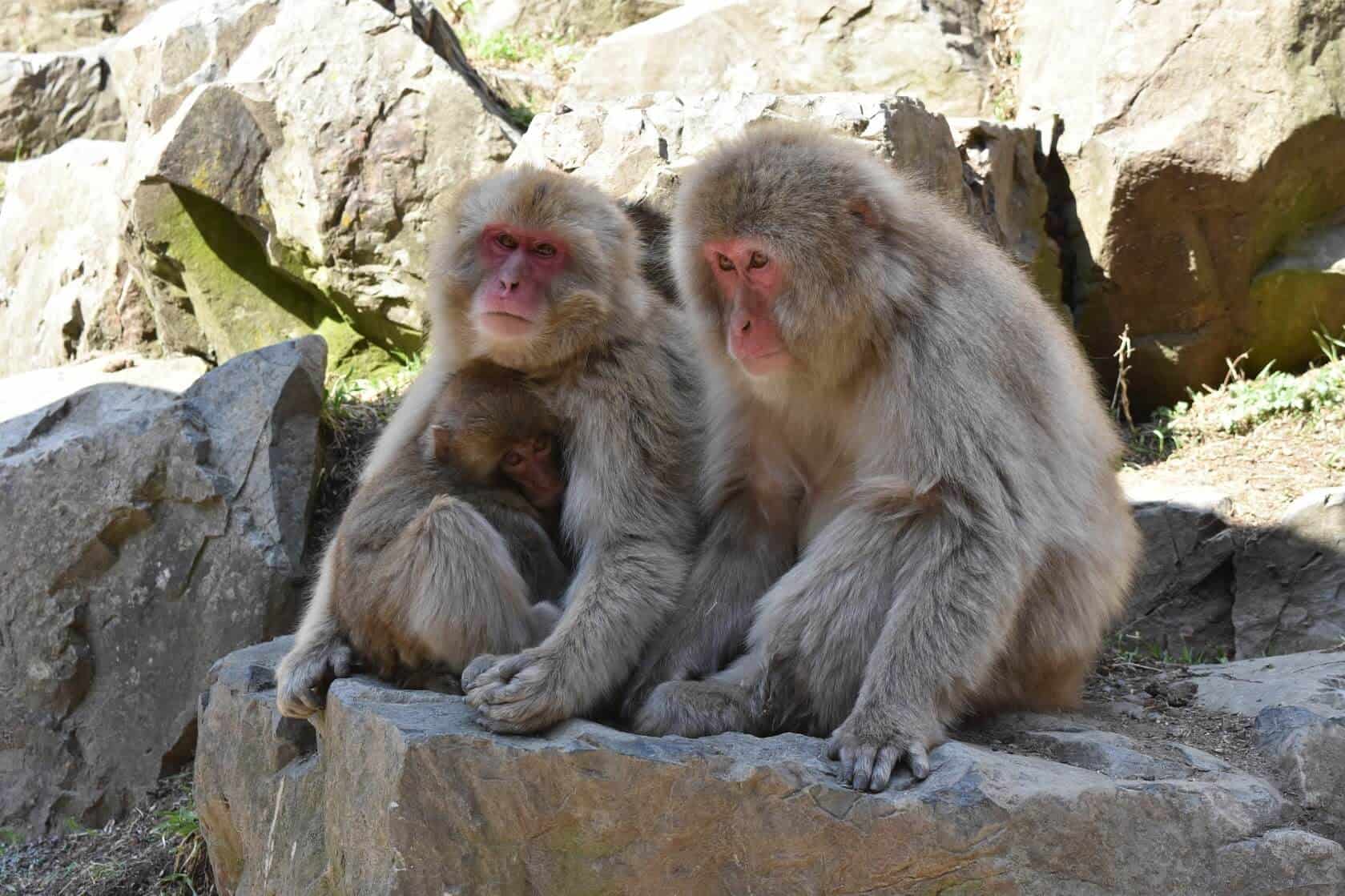
If you’re visiting Japan in the winter, I highly recommend visiting the Jigokudani snow monkey park! It’s a short day trip from Tokyo (2 hours via train) and you can even stay overnight and explore the surrounding Nagano prefecture.
The park is located in a crater that’s called Hell’s valley due to the warm temperatures and hot springs that surround the area. The monkeys soon noticed and made their home here in the 1960’s. Today you can visit and see the monkeys enjoying their natural habitat. If you get lucky, you can even see the baby monkeys bathing in the hot springs amidst falling snow!
Although the monkeys are used to humans, be sure to keep a safe distance – when we were there, one monkey started yelling at a guest because he was too close!
The entrance fee is 800 Yen (about $7.50USD). I recommend checking the park’s web camera before visiting and getting there in the beginning of the day (around 9AM or 10AM) before the rest of the crowds arrive.
Nominated by Adventures with Luda
The Crow Castle of Matsumoto
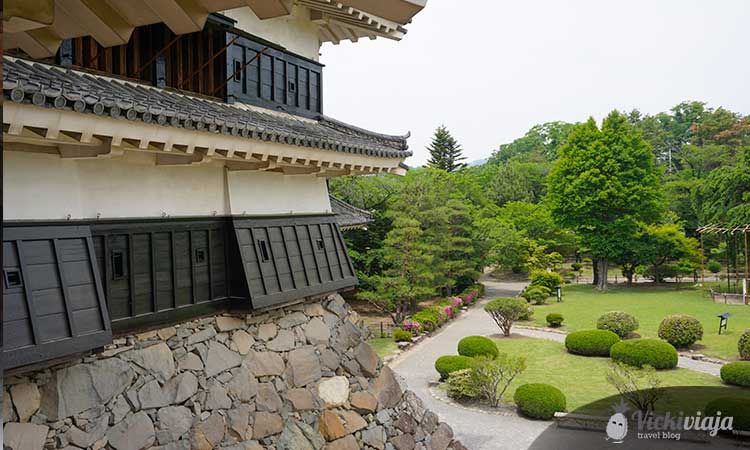
When visiting Japan, many people haven’t heard of Matsumoto before and therefore oversee this great travel destination in Japan. It’s a shame, though, because Matsumoto is home to one of the most beautiful castles in Japan: The Crow Castle of Matsumoto.
Visiting this impressive castle is easy as they are signs everywhere guiding you to the castle. The best part about a visit to the castle is that at the entrance, you can find many volunteer guides. Many of them are already retired and do the tours as a hobby, others simply want to practice English or another language. Our guide spoke English and Spanish and was more than happy to practice his language skills with us.
The castle itself is amazing. It’s big, gorgeous and full of exhibits that tell you more about the Japanese life and culture at the time of the Edo era. Since many exhibits don‘t have information (in English), we were even happier to have our guide with us that could explain to us all about the history of this place.
Nominated Vickiviaji
Teshima and Naoshima Art Islands
If you’re looking to get away from the crowds in Japan and visit somewhere so special and jaw-dropping amazing, the Art Islands based in Kagawa Prefecture are an absolute must visit. It takes about three hours to get to from Osaka with a combination of taking two trains and a boat to the once nearly abandoned old fishing islands.
Most people spend a few days visiting these islands but you can visit in one day if you plan correctly.
Teshima being the quieter island houses one of the most interesting and futuristic art museums you’ll probably ever see in your life. Hire an electric bike from Takamatsu Port (you’ll need one as there’s hills to climb) and cycle up through the rice paddies to come to the futuristic Teshima Art Museum.
As you enter the museum, you’ll feel like you’ve arrived at another planet. What you witness in this museum is a sight that’s so unexplainable, it will stay with you forever.
Naoshima is the more popular and easier to get to island from Uno Station. You can hire an electric bike or take a bus around this island. With pieces from famous Japanese artist Yayoi Kusama dotted around the island such as the Yellow Pumpkin, the most spectacular gallery is the Chichu Art Museum built by Tadao Ando.
This gallery was specifically built around the art pieces and underground. The only lighting you’ll see in the entire gallery is natural light which is just mind blowing seeing that it’s an underground gallery. Just wait until you see the Monet, you won’t have ever seen a more beautifully curated piece of work in your life.
Even if art isn’t your thing, I can guarantee the art islands will give you the best memories of your entire Japan trip.
Nominated by Londoner In Sydney
Go Skiing at Myoko Kogen
There are many places to go skiing, but few can lay claim to some of the driest powder snow in the world like Japan. This is just one reason why we think skiing in Japan is the perfect addition to your Japan Winter bucket list.
There are hundreds of ski resorts to choose from on both the north and main island. One of our favourite destinations is Myoko Kogen, west of Nagano. The area receives an average of 14 metres of snow per year and regularly has a 4 metre base. There is no shortage of snow!
Not only that, the resort has English speaking ski instructors (which is especially great for kids) and a good range of beginner, intermediate and advanced runs to suit the whole family. At the end of the day a visit to one of the hot thermal onsens is essential before heading out to try some of the local dishes such as ramen, sushi and okonomiyaki.
But what really makes a trip to Myoko Kogen unique is that the town is smaller and less westernised than some of the larger ski resorts like Hakuba and Niseko. It makes for a wonderful, authentic Japanese experience.
Nominated by Adventures and Sunshine
Swim with Manta Rays at Okinawa
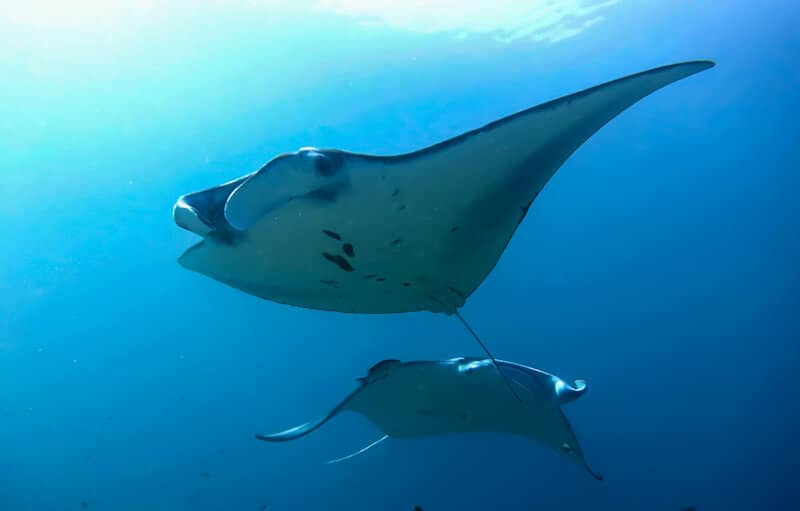
Okinawa is an archipelago made up of 160 idyllic, paradise islands located 400 miles (640km) south of the mainland.
Despite the millions of foreign travellers visiting Japan every year, Okinawa remains off the tourist radar and makes a perfect tropical destination for anyone looking for a relaxing, beach getaway with a Japanese flair!
Due to the warm weather year-round and clear turquoise waters surrounding the white sand shorelines, Okinawa offers some incredible snorkeling and scuba diving. One island that attracts scuba diving enthusiasts is Ishigaki, known for manta ray sightings between June to September.
If you have never seen manta rays, they are some of the biggest rays that can reach up to 7 meters in diameter. Witnessing these majestic animals is mind-blowing, and an experience you will never forget.
After I encountered my first manta rays in Bali, I immediately got hooked on scuba diving, and I haven’t stopped diving since! I have dived with manta rays many times since then, but seeing the graceful “flying carpet” of the ocean is magical every single time. You can never get tired of seeing these beautiful creatures.
You can reach Ishigaki by taking a domestic flight from Naha (the main International Airport of Okinawa) or Narita on Japan’s mainland.
Nominated by Travel Lust 101
The Big Buddha in Kamakura
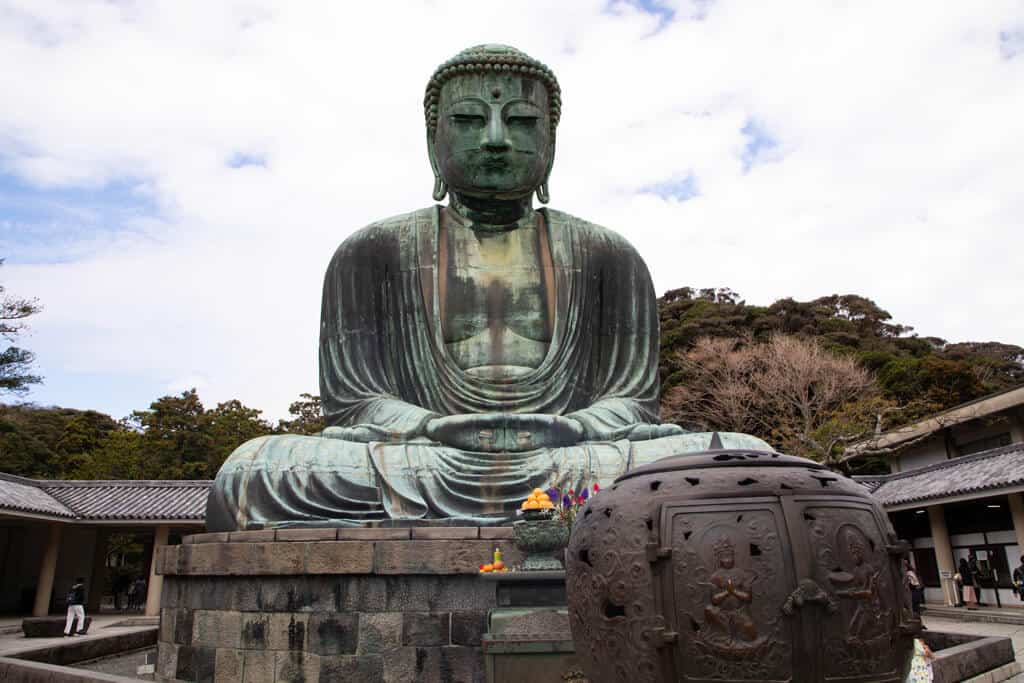
Kamakura Big Buddha – Japan Hidden Gems
The Big Buddha, or Daibutsu, is one of the most important sights of Japan. Having withstood relocations, fires, floods, and war, the Big Buddha has been through it all, giving hope and peace to everyone who visits. Upon entering the Kotokuin Temple, the Buddha sits tall.
Offerings are laid around him and visitors can also go inside of him to see how he is put together. While there, notice the coin offerings stuck in his seams from pilgrims looking for good fortune. Visit Kamakura and don’t miss the Daibutsu. To get to the Kotokuin Temple, you must take a special train from the main Kamakura station, called the Enoden, then walk about three city blocks.
The cost of entry is only 200 yen, and it is well worth it. Take time to look outside the temple for Buddha souvenirs as well.
Nominated by Reflections En Route
Use an onsen in Hakone
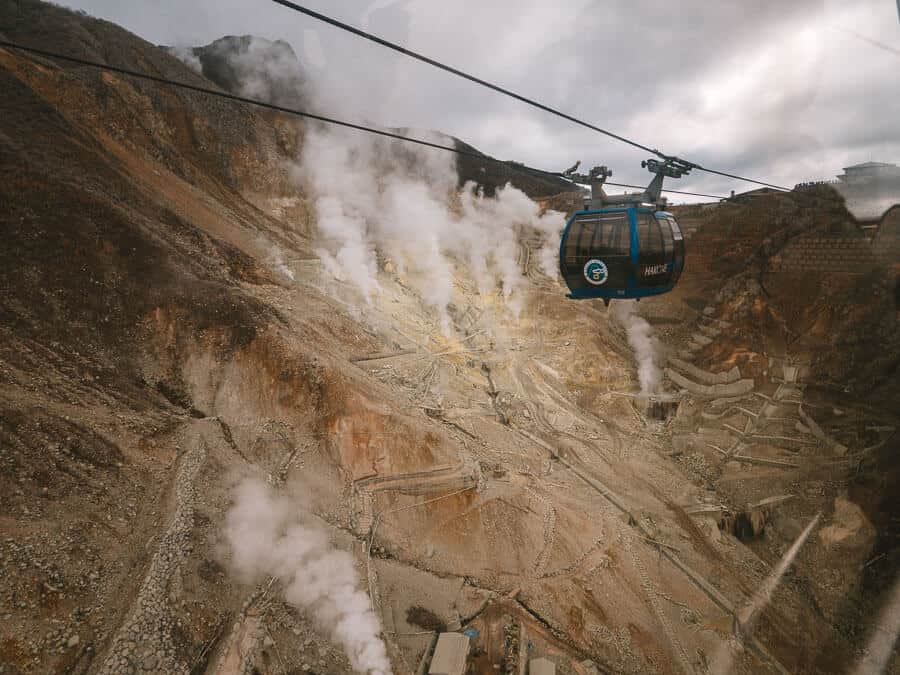
Hakone should be on your Japan Bucket list
Hakone is one of my favourite places in Japan. Located about one and a half hours train ride from Tokyo, Hakone is the perfect place for a day trip. But it’s an even better place to spend a few blissful days exploring the mountains, hiking and soaking in a traditional Japanese Onsen (hot springs).
Hakone has literally hundreds of Onsen dotted around the towns, which are all fed from the thermal springs produced by Mount Hakone, an active volcano. Many Onsen are situated in hotels and guest houses, but there are also public Onsen available.
I recently spent two blissful nights staying in a traditional Ryokan (Japanese Inn), called Hakone Gora Byakudan, where we had our own private Onsen right on our balcony, overlooking the valley and Lake Ashi.
Other things to do around Hakone include; visiting the Hakone Open Air Museum, riding the Hakone Ropeway up to Owakudani so see the volcanic gases spilling out from Mount Hakone, riding a boat around Lake Ashi and visiting the beautiful Hakone Shrine.
And if you are traveling to Japan pregnant and thinking about including an onsen in your Japan itinerary check out this post.
Nominated by Fly Stay Luxe
Okunoshima – The Rabbit Island
Japan is obsessed with all things cute, or “kawaii” in Japanese, and what is cuter than a bunny? How about 1,000 bunnies! Okunoshima, or Rabbit Island, is one among several areas in Japan densely populated by adorable animals. Miyajima is known as Deer Island, Tashirojima is Cat Island, and there is also Zao Fox Village, to name a few.
As the name suggests, this island is covered in rabbits! They are friendly and eager to meet you, especially if you have food. Rabbits were used for chemical weapons testing on this island during and prior to WWII, however, these rabbits are descended from rabbits that were let loose as a practical joke!
Walk around the island, enjoy the beach and the visitors center, but don’t forget to bring your carrots to feed the rabbits!
Okunoshima is part of Hiroshima Prefecture and is a short ferry ride away from the mainland. It’s a fun and unique place to visit, and so kawaii!
Nominated by Join the Kellys
Hirosaki castle
Visiting Hirosaki castle and grounds during cherry blossom season in the spring is one of the most beautiful spots in all of Japan to view the beautiful array of sakura. The castle is nestled along the banks of a river and surrounded by thousands of different varieties of cherry trees creating the perfect scene from a fairytale.
Take a stroll through the grounds, or have a picnic under the canopy of pink petals as they twirl and dance in the light breeze. Try different sakura flavored treats such as ice cream and pastries from local food vendors that make their appearance only this time of year.
There is something very special about cherry blossom season in Japan that awakens the country from what feels like a long winter hibernation, and allows visitors to see the beauty and importance these trees have on the culture and people of Japan.
Nebuta festival
Once a year in Aomori you can witness and be a part of the special Nebuta Matsuri festival. Held every August this city comes alive with parades accompanied by taiko drums, musicians and various dancers.
The highlight of the festival and parade are the large floats made almost entirely out of washi paper that have been carefully constructed and designed all year long. These floats are works of art that highlight the Japanese culture both historically and modern day.
It is a great opportunity to volunteer and get involved in the customs and traditions that northern Japan has to offer by participating in the parade, pushing the floats, or learning and performing in the many different dances. Don’t miss out on the highlight of the summer in this fun city.
Nominated by Aboard Life’s Journey
What is top of your Japan Bucket List? Do you know about a Japan hidden gem that isn’t featured on this list?
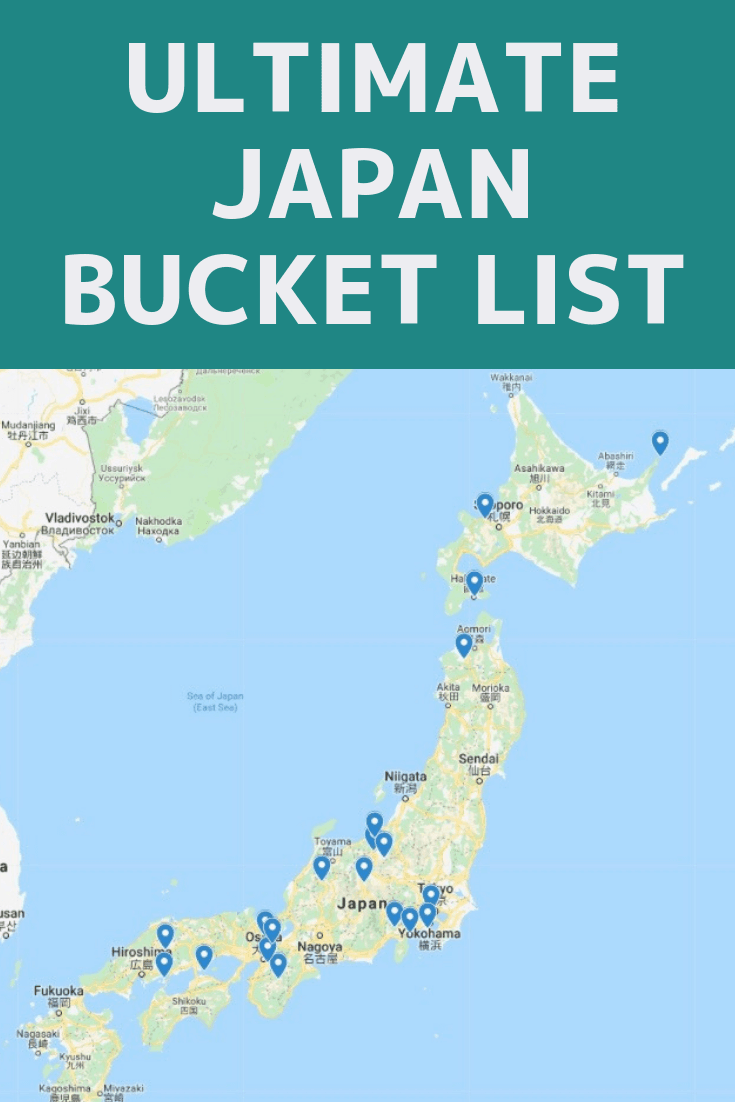

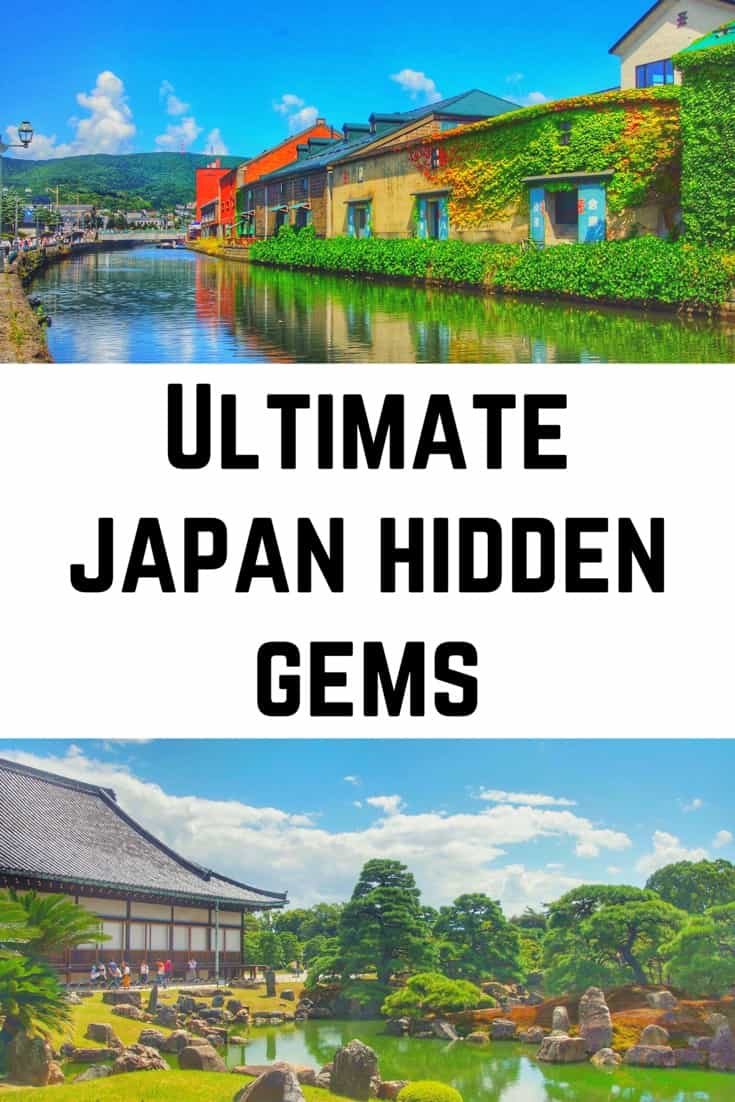
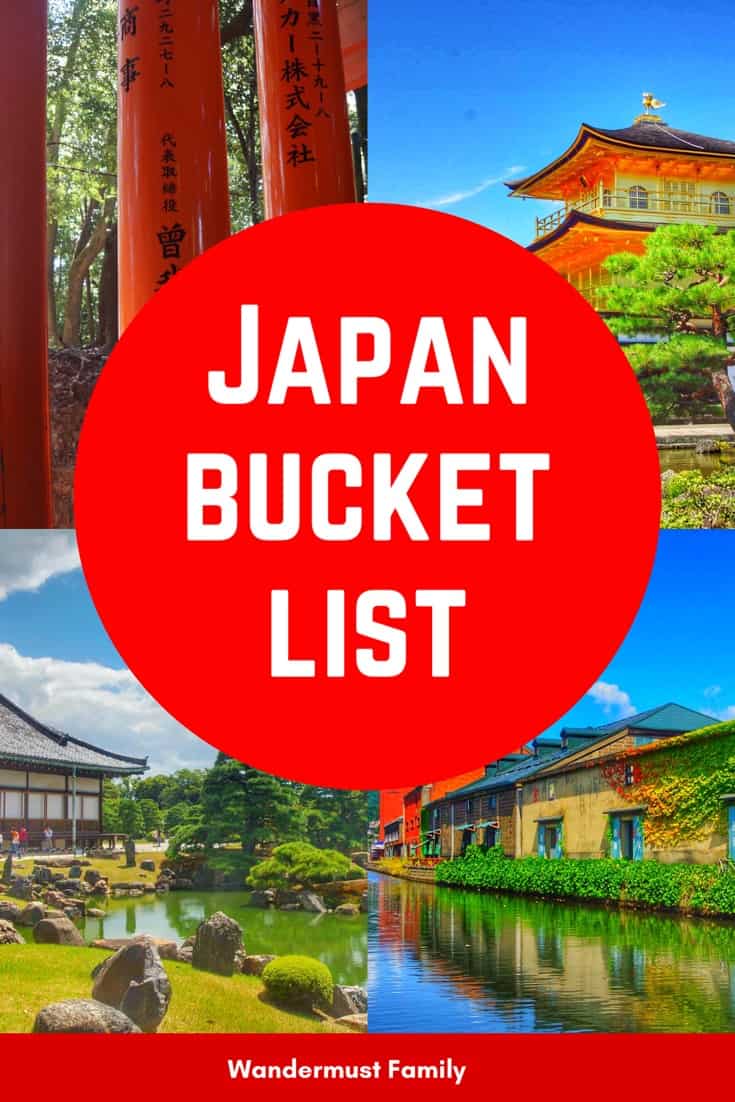

Ada
Sunday 17th of March 2019
This is the reason why I generally don't recommend JR Pass to my Japanophile friends. It's so much better to travel and explore Japan slowly by just keep coming back to it. I'm just glad I live in Japan, but I still feel like I haven't really explored a lot!
Katy Stern
Sunday 10th of March 2019
Japan is definitely bucket list worthy. It looks an incredible place to visit, what a fab post Leona for anyone planning a visit to Japan!
Thanks for linking up to #Mondayescapes
Daisy - Dais Like These Family Travel Blog
Tuesday 5th of March 2019
Wow, this really is a bumper list! I've never been before, but I'd love to one day. This post is a great resource for anyone planning their visit to Japan. Thanks for linking up to #MondayEscapes
Jemma Taylor-Smith
Monday 4th of March 2019
Japan is definitely on my bucket list and this is such a great post! I'll definitely be referring back to it if we ever get to go! Jemma #MondayEscapes
Keri | Ladies What Travel
Tuesday 26th of February 2019
What.An.Epic.Guide! I'll definitely be bookmarking this! You mentioned several things I did in Tokyo and many that I wanted to but ran out of time for! I'd love to go back to Japan and explore beyond the capital its amazing place and your post has made me want to visit more than ever! #MondayEscapes
Wandermust Mummy
Thursday 28th of February 2019
I think that’s the biggest problem visiting japan - you think you’ve got enough time by it is literally never enough! What was your fave hung in Tokyo?